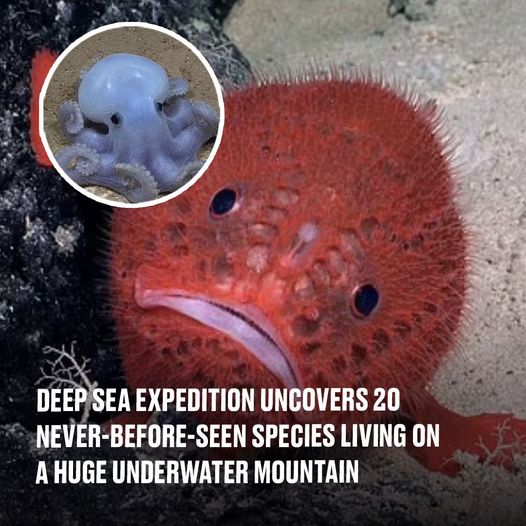While mapping an unexplored seamount on the Nazca Ridge, oceanographers have discovered 20 new species and captured footage of extremely rare creatures. The Nazca Ridge is located in the deep sea far off the coast of Chile in international waters, and it is one of several locations that may be designated as a high seas protected area. The discovery came as part of an expedition led by Schmidt Ocean Institute in collaboration with Ocean Census and the Center for Coastal and Ocean Mapping/Joint Hydrographic Center at the University of New Hampshire.
The Nazca Ridge Deep Sea Expedition

The seamount, also called an underwater mountain, is over 3109 meters/1.9 miles high and houses a diverse deep-sea ecosystem including ancient corals and sponge gardens. While mapping the seamount and conducting ROV surveys, the team of oceanographers discovered multiple new species (they suspect 20 in total) and captured footage of rare animals with only a few existing specimens.
“Upon concluding our third expedition to the region, we’ve explored around 25 seamounts on the Nazca and Salas y Gómez Ridges,” said Co-Chief Scientist and Schmidt Ocean Institute Marine Technician, Tomer Ketter. “Our findings highlight the remarkable diversity of these ecosystems, while simultaneously revealing the gaps in our understanding of how the seamount ecosystems are interconnected. We hope the data gathered from these expeditions will help inform future policies, safeguarding these pristine environments for future generations.”
Some of their noteworthy finds include:
Promachoteuthis squid

This is the first-ever captured footage of a Promachoteuthis squid, which has only been known from dead specimensthat were accidentally caught in nets. As a result, very little is known about the Promachoteuthis squid.
Casper octopus

They also documented a Casper octopus, also known as a ghost octopus. Discovered in 2016, they have no formal name or scientific description as of yet. It is the first time this species were found in the Southern Pacific Ocean. Their nickname reflects their pale, pigment-less body. It is a part of the group of incirrate octopuses. In fact, it is the only member discovered at these depths. Other members of this category include the Common Octopus as well as the Giant Pacific Octopus.
Flying spaghetti monsters

Their ROV also found two Bathyphysa siphonophores 665 meters below the surface. They are also called flying spaghetti monsters, named after the satirical deity. They are carnivorous colonial organisms, meaning they are made of multicellular units. Scientists have yet to understand how the colonies function seamlessly as one entity. Flying spaghetti monsters eat small fish and crustaceans.
Scorpion fish

This creature seemed to love the camera in the photos the Schmidt Ocean Institute posted on social media. “This scorpion fish gave us more looks and poses than a runway model, and with coloration like that, we were entranced before the first turn.”
Scorpion fish are solitary creatures with distinct colors that blend with their environment so they can evade predators and ambush prey. Their spikes contain venom to stun their targets before consuming them. This potent venom makes them one of the most poisonous animals in the ocean.
Oreo fish

Named after the famous cookie, Oreosmatidae are a type of deep sea fish mainly found on seamounts, although their eggs and larvae float towards the surface. Adults eat small fish, crustaceans, and cephalopods, along with shrimp and krill. Research speculates that they can live to be more than 80 years old.
Torpedo rays

The Nazca Ridge expedition also caught footage of a torpedo ray, also known as electric rays. Their name reflects their ability to produce electrical shocks that stun prey and ward off predators. Fortunately, they don’t attack people but they can still emit a painful shock if stepped on, although the voltage depends on the specific type of ray.
Discovering New Life in the Deep Sea

Before Schmidt Ocean Institute’s 2024 expeditions, marine experts knew of 1,019 species residing in this part of the Pacific. Now, there are over 1,300 and potentially much more.
“The seamounts of the Southeastern Pacific host remarkable biological diversity, with species found nowhere else to date,” said Professor Alex David Rogers, Science Director of Ocean Census. “The work our taxonomists have conducted aboard Falkor (too), supported by Schmidt Ocean Institute team, will significantly enhance our understanding of the distribution of remarkable life forms on these underwater mountains, including several that have never before been mapped or seen by human eyes.”
